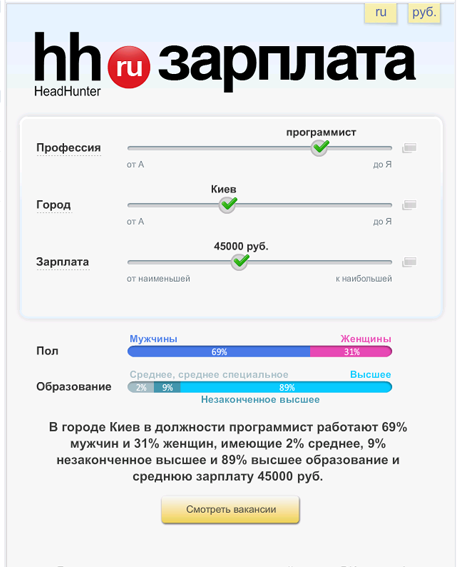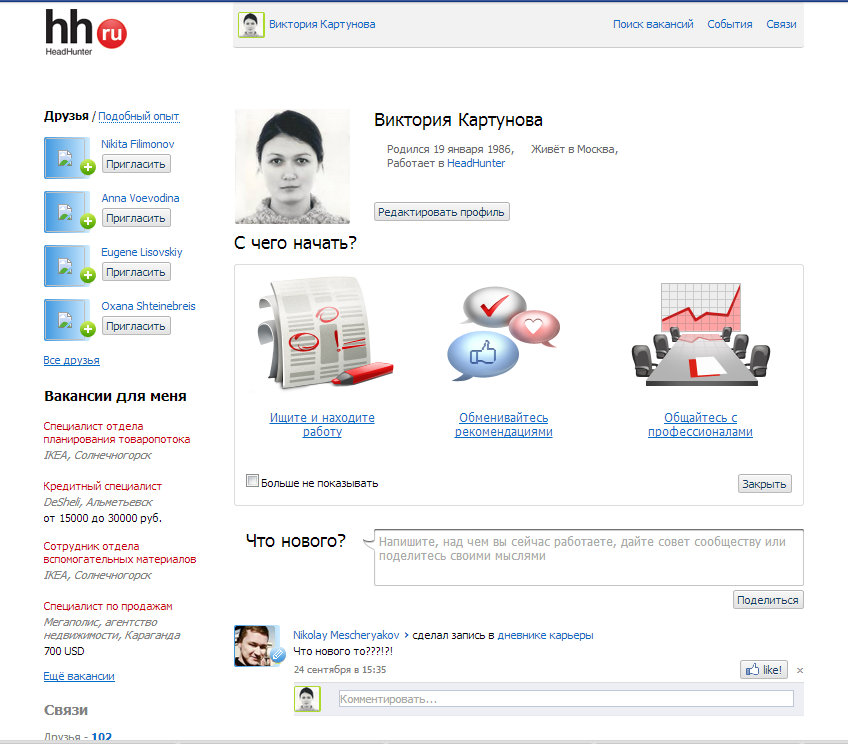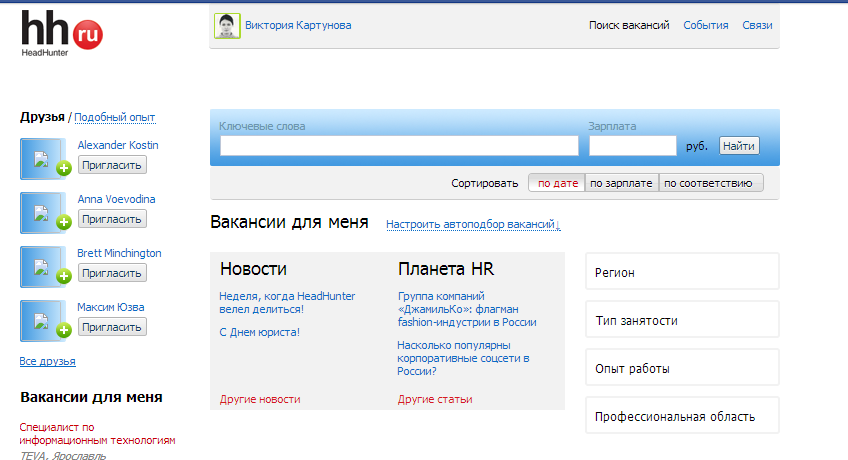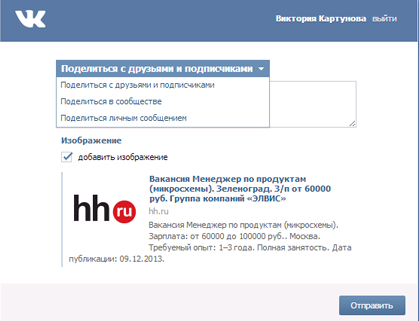Four HeadHunter experiences in social networks

We recently released the HeadHunter Jobs app for social networks to help job seekers. The application "lives" in " Facebook " and " VKontakte " and allows you to receive a daily selection of suitable vacancies from hh.ru. For the first couple of weeks, it was installed by about 4.5 thousand people, but this is not our first experience.
In this review, I present to your attention a retrospective of our social and applied presence with lessons learned at each stage.
')
Experience number 1: "hh.prognoz"
The first approach to the projectile was the application “ hh.prognoz ” (internal code name - “Fortune teller”) in VKontakte.
Startup time: April 2011.
The purpose of the application: to increase the coverage of the audience hh.ru at the expense of the users of VKontakte, to create a stable link through an entertainment application with a casual element.
Principle of action: the user enters a date of birth and receives a calendar of favorable and unfavorable in terms of the next five days. It is possible to send the result to yourself on the wall and “tell fortunes” to a friend (from the VKontakte friends list) by sending the result to him on the wall.

Despite the frivolous shell, the application is packed with a complex mechanism of data mining of the HeadHunter database. After the user enters the day and month, it finds all applicants with the same date of birth in the database and checks on which days they were invited for interviews and which were refused. Based on these data, the most favorable day is displayed for sending a resume and applying for a job.
It should be noted that at the time of launching the application, mining was carried out on the basis of 5 million users. Now, the number of applicants exceeded 11 million, but the result is still as fast.
The application was met ambiguously in the IT environment. For the most part, due to the fact that very few people could see the serious mechanism: they saw only the “cheerful” design and the format of the “fortune-teller”. In particular, Alyona Vladimirskaya in her Facebook wrote something like the fact that HeadHunter, as a brand, cannot afford such things (unfortunately, we could not find the link link. Perhaps, due to mature thinking, Alyona removed the post when she launched its “ toy with a lot of sense ” ( PruffiGraph ). However, the users of VKontakte did not see this application with such skepticism: the application did not advance at that time, now it is not supported, but the number of installations continues to grow slowly (at the moment there are 11,750).
Lessons: the main lesson, as I see it now, is clear goal-setting and positioning. If the application is entertaining, then it should have more entertainment element and less cost for such a complex development, as the data mining site. If a serious mechanism is used, then it should be submitted accordingly, so that it is clear that the basis is complex mathematics. When formulating goals, it is necessary to set criteria by which it will be possible to determine whether these goals have been achieved or not. Because about the "hh.prognoz" you can only say that he is, that he has a certain number of installations - that's all.
Experience number 2: "hh. Salary"
The second in the social network (and again "VKontakte") was released the application " hh . Salary " (internal name - "Sliders"). Application development was conducted in parallel. Both were produced as part of a large project “Career Statistics”, the goal of which was to make the most of useful data stored in the huge HeadHunter database - to make the numbers work, and not accumulate without cause, like in the closet of Plyushkin. On the site itself, within the framework of this project, the hh.index application was implemented with a conservative interface and the absence of an engaging component: came, received information, left.
Startup time: May 2011 (estimated time, the official release did not take place).
The purpose of the application: to increase the awareness of HeadHunter due to a similar presence in the social network; provide users with useful statistics and encourage further transitions directly to the site.
Principle of action: the user sets two parameters out of three - profession, city, salary. After this, the third parameter is determined automatically. You can select parameters by moving the "sliders", or you can from the list. The result is a certain cut: how much does a representative of a particular profession get in a particular city, who prevails in the profession - men or women, and what is their level of education.

After the application issues a “portrait” of the profession, a button to go to the corresponding vacancies on the website hh.ru appears.
According to the plan, hh. Salary was supposed to be of interest not only to applicants, but also to employers: a quick and free way to find out the average salary level by profession and by region. However, for serious work, this tool is not suitable.
The official announcement of the launch of "hh. Salary" did not work. The application exists, it has a couple of thousand installations, but it is not supported or promoted. The paragraph below you will find out why.
Lessons: at the start it became clear that the application does not have a pronounced value for the user: the “fan” was not quite enough to play “sliders” every time, and the mechanics did not assume that the person would return again and again.
The main mistake was that they were coming from technologies, and not from the needs of the audience: an idea appeared to extract data from the database for general use, and a feature was invented.
One of the indicators of the success of the application was to be the conversion to the registration of a new user on the site (registration and summaries are needed to respond to the vacancy; it was assumed that by going from the application to the vacancies the user would want to respond to some of them). However, in reality, the conversion was negligible.
But we got an excellent experience in extracting data from the database, much has been clarified. And it is very useful in the work on the following applications.
Experience number 3: HeadHunter app
In parallel with the first two applications for VKontakte, work was underway on an application for Facebook.
In 2011, it was already clear that supporting the project livehh.ru - the professional community, and in fact its own thematic social network - does not make sense. An active audience actively communicated on the topic of career and work where it was convenient and familiar to her - in large social networks.
Before closing livehh.ru, it was necessary to develop an alternative on one of the popular platforms where people could communicate, engage friends, share career achievements and plans - all this in relation to HeadHunter.
“Facebook” was chosen as the site for implementation, as the qualitative composition of the audience of this network seemed to be the most relevant to the audience of hh.ru, and the behavior in this network (maintaining professional connections rather than searching for old friends) was most consistent with the goals we pursued.
For advanced users - middle managers and managers - the HeadHunter app was launched.
Startup time: February 2012.
The purpose of the application: to create a professional community with an active audience on Facebook, which could replace the deceased Livehh.ru in Bose and compete with BranchOut and LinkedIn.
Principle of action: the application combines the functions of a career diary, service of mutual recommendations for colleagues, as well as the distribution of relevant suitable vacancies.

In order for the profile to have all the information about the places of work of the user, before installing, you need to fill in this information in your Facebook profile. When you install the application, it is imported into the user profile inside the application.
After installing the application, you need to add information about your work experience to get something like a resume. When the business profile is ready, you can invite friends to the app and follow their work news. When inviting a friend, the user indicates the type of communication with him - they studied together there, they worked together there, thus the profile of the friend is filled out.
Also, the application allows you to customize the selection and get the appropriate job without visiting the site. By this time, the site hh.ru already had api, which was actively used in the distribution of vacancies on other sites. With it, the flexible output of various data from hh.ru was successfully carried out.

Integration with Facebook has some difficulties. Applications in the Facebook interface are inconvenient and not obvious. It takes a lot to sweat to find even an already installed application. It only makes sense to enter them through notifications, but at that time it was not possible to integrate into the notification system due to security restrictions.
The launch of the application was announced by HeadHunter, but there was not much excitement among users. Now it is essentially dead, but its corpse is still on the Facebook platform. We hope that it is not next to the “Birthdays” application, which passed away from multiple user installs, which specifically for him learned to go into the application settings and delete them.
Lessons: Difficulties arose not only because of Facebook’s hostile environment. The very essence of the application was not obvious. It wanted to simultaneously implement too many functions, because of which its goals and values were blurred.
For the application to work correctly, the user needed to fill out a bunch of information in the profile (which is already a minus in general, because even the resume on the site itself is not very readable). The benefit he receives after such zeal is not entirely clear to him. Why should he specifically keep a career diary, if he can just talk about his projects in his main tape, interspersed with other posts?
Well, in general, the social network inside the social network is a little strange add-on.
But in the application it was convenient to customize the search and get the appropriate job. This we have noted.
Experience number 4: "HeadHunter Jobs"
Analyzing previous experience, we came to the conclusion that an application focused on one particular function will be more efficient and effective. The most obvious solution was the creation of a personalized recruitment of vacancies, which can be obtained in social networks.
In general, the mechanism is similar to “ auto-searches ”, which are configured on the website hh.ru and allow you to receive the corresponding vacancies by mail. With the only difference that it is not necessary to go either to hh.ru, or in the mail.
Startup time: November 2013.
The purpose of the application : to deliver jobs to users where it is convenient for them; as a result - an increase in traffic, registrations and level of conversion.
The principle of action: the user adjusts the parameters of the vacancies that interest him: the region, salary, profession - and once a day receives a list of relevant vacancies, with heat, just posted on the site.


The prerequisites were as follows:
- postmaster statistics from mail.ru showed that 19% of emails from hh.ru (including those with “autosearch” results) are deleted unread;
- Own user survey showed that 5% of our audience use social networks for job search (at the time it is 400 thousand users);
- the overall increase in the amount of time users spend on social networks (at that time it is 9.6 hours per month ); taking into account the "passive" time when the account is simply open in one of the tabs.
Initially, the orientation was on “Facebook” because of the popular belief that this audience is more correlated with the audience HeadHunter. However, by that time we had already closely studied social networks. VKontakte indicators were better on many points: for example, the monthly traffic from this network to the site hh.ru was five times more than that of Facebook; the total number of conversions to certain actions (registration, job application, resume editing, etc.) is 10 times more; and the conversion level itself for all actions above.
Therefore, during the development process, a reorientation was made to VKontakte . Fortunately, this technically required very few modifications, since the application is placed both there and there using the same size iframe. Most of the improvements were related to notifications and various ways of “sharing” vacancies.
Particular attention in the mechanics of the application is given exactly the possibility of passive search. The person installs the application to be aware of interesting offers on the market, and it is not at all necessary that he is looking for work.
Alerts embedded in the general Facebook notifications and in notifications from VKontakte applications encourage users to regularly go to the application.
And, of course, since the job search is a delicate area, “HeadHunter Jobs” do not publish anything on the user's wall without their consent. However, it remains possible, if desired, to share a vacancy on your wall, or on a friend's wall, and also send it in a personal message on VKontakte.


In order to view the full information about the vacancy or respond to it, you need to go to the website hh.ru. A utm-tag is automatically substituted into all links, thanks to which we can now accurately track not only the number of transitions, but also the behavior of users on the site.
Already, we see that conversion in responses from the application is 3% higher than the overall site, and in registration it is 4 times higher than the average for the site (application indicators in VKontakte , traffic from it is 7 times higher than from the application in Facebook ).
At the moment we have collected a small pool of improvements that will make working with the application even more convenient.
Also in the near future is the launch of an application for employers on Facebook, which allows broadcasting company vacancies in the chronicle of the corporate page. Wait very soon!
Results: it is easy to notice that elements of the HeadHunter Jobs application were present in almost all previous applications. However, it took time and experience for us to come to this, at first glance, the obvious solution - to remove all unnecessary and provide users with maximum benefit.
What conclusions we made for ourselves:
- The application must contain a distinct value for the user.
- The application should not be a one-time, its mechanics should imply a permanent user connection with the service.
- The application should be as simple as possible in the settings.
- The application must respect the user's privacy (in the area of job search, this is especially important).
- The application must either be improved or buried and moved on. There is no third.
Source: https://habr.com/ru/post/206422/
All Articles